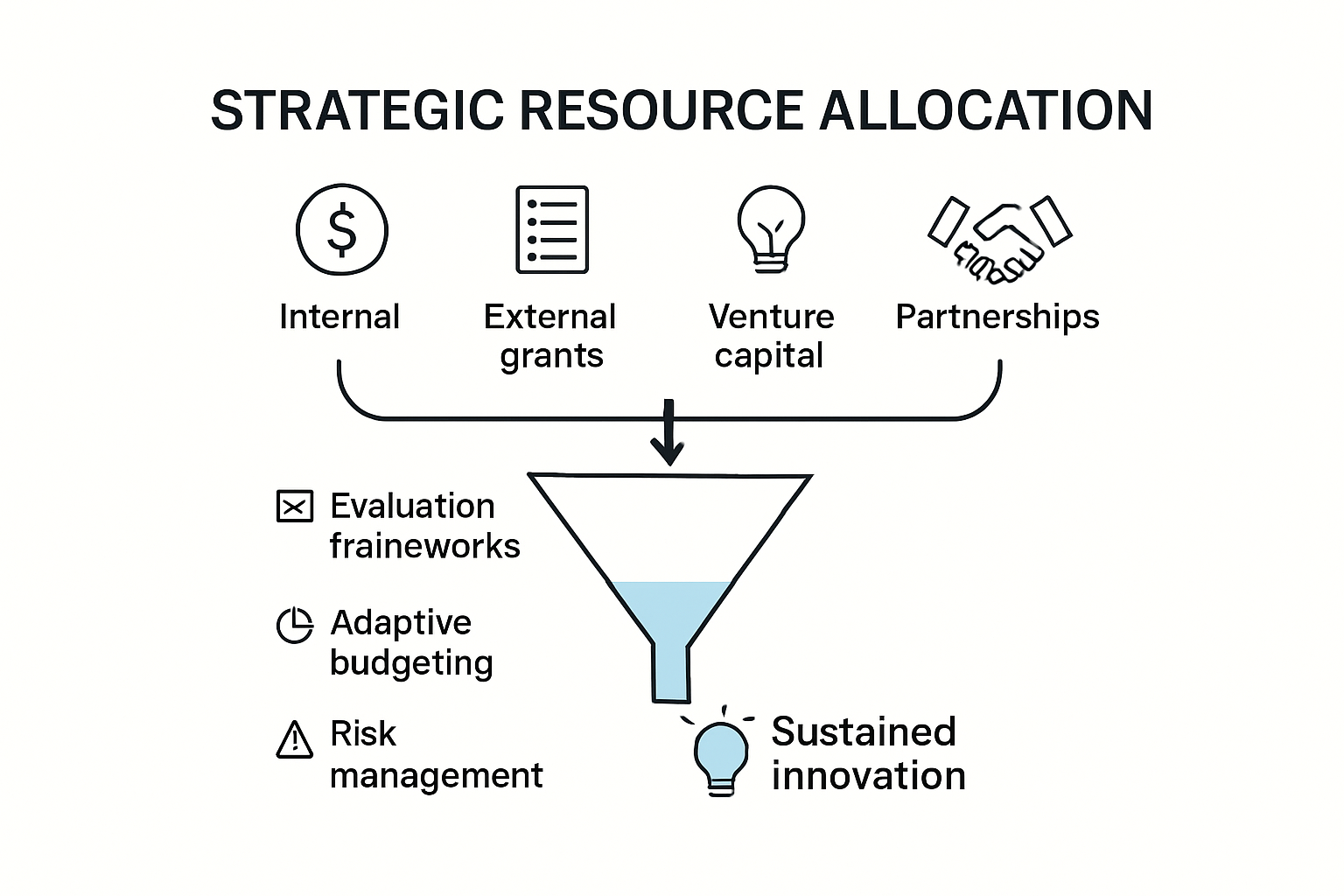


How to Foster Innovation: Practical Steps for Leaders
Leaders everywhere claim to want innovation, yet most struggle to spark real creativity within their teams. It might sound wild, but psychological safety is a bigger influencer of radical innovation than factors like budget or strategy. The real power does not come from throwing more money at big ideas, but from building organizations where new thinking is not just welcomed, it is protected like a rare resource.
Table of Contents
Quick Summary
TakeawayExplanationEstablish Psychological SafetyEncourage open sharing of ideas without fear of repercussions.Implement Collaborative EcosystemsDesign environments that promote teamwork and knowledge sharing.Develop Flexible Funding MechanismsCreate adaptable financial structures for innovative projects.Measure Innovation HolisticallyUse comprehensive metrics for assessing innovation impact.Sustain Innovation Through Continuous LearningFoster a culture that values experimentation and growth.
Building a Culture of Innovation
Innovation is not a spontaneous event but a carefully cultivated organizational ecosystem that requires intentional strategy and leadership commitment. Leaders play a critical role in creating an environment where creativity can flourish and breakthrough ideas can emerge.
Establishing Psychological Safety
Creating a culture of innovation begins with establishing psychological safety within teams. Research from MIT Sloan Management Review demonstrates that corporate culture is a more significant driver of radical innovation than external factors. This means leaders must actively create an environment where team members feel safe to share unconventional ideas without fear of ridicule or professional repercussions.
Psychological safety involves several key practices. First, leaders must model vulnerability by openly discussing their own failures and learning experiences. This demonstrates that mistakes are not career-ending events but opportunities for growth. Second, team members should be encouraged to challenge existing processes and propose alternative solutions without hierarchical barriers. Third, recognition and reward systems must explicitly value innovative thinking, not just successful outcomes.
To help leaders implement psychological safety effectively, here’s a summary of key practices and their intended impact within organizations:
PracticeDescriptionIntended ImpactModel VulnerabilityLeaders share their own failures and learning experiencesNormalizes mistakes as learning opportunitiesEncourage Challenge of ProcessesTeam members can question existing norms without hierarchy fearsEnables open sharing of unconventional ideasRecognize and Reward InnovationExplicitly value innovative thinking, not just successful resultsMotivates risk-taking and creative contribution
Designing Innovative Communication Channels
Effective innovation requires robust communication infrastructure. According to EDUCAUSE Review, organizations can stimulate innovation by creating intentional communication strategies that support inclusivity and new idea generation. This might include regular brainstorming sessions, cross-functional collaboration platforms, and dedicated time for creative exploration.
Leaders should implement structured yet flexible communication mechanisms that allow ideas to flow across traditional organizational boundaries. This could involve periodic innovation workshops, digital suggestion platforms, or rotating team compositions that bring together diverse perspectives. The goal is to break down silos and create opportunities for unexpected connections and insights.
Continuous Learning and Experimentation
Sustaining an innovative culture requires a commitment to continuous learning and controlled experimentation. Organizations must view innovation as an ongoing process rather than a one-time event. This means creating systems that support rapid prototyping, learning from failures, and iterative development.
Leaders can support this by allocating resources for skill development, providing innovation training, and establishing clear frameworks for testing and implementing new ideas. Our comprehensive guide on building sustainable innovation processes offers deeper insights into developing robust innovation infrastructures that encourage continuous organizational learning and adaptation.
Ultimately, building a culture of innovation is not about implementing a single strategy but creating a holistic ecosystem that values creativity, encourages risk-taking, and transforms organizational mindsets. By focusing on psychological safety, intentional communication, and continuous learning, leaders can unlock their team’s innovative potential and drive meaningful organizational transformation.
Empowering Teams Through Collaboration
Collaboration is the cornerstone of innovative organizational success. Modern leaders recognize that breakthrough solutions emerge not from individual brilliance but from collective intelligence and synergistic team dynamics.
Creating Collaborative Ecosystems
Research from Berkeley Executive Education emphasizes that effective collaboration transcends traditional teamwork by fostering a shared vision, trust, and commitment to collective success. Leaders must intentionally design environments that encourage cross-functional interaction and knowledge sharing.
Building collaborative ecosystems requires strategic infrastructure. This means creating physical and digital spaces that facilitate seamless communication, implementing collaborative technologies, and establishing clear protocols for idea exchange. Virtual collaboration platforms, regular interdepartmental meetings, and shared project management tools can break down organizational silos and create pathways for innovative thinking.
Developing Team Empowerment Strategies
A study published in Management and Organization Review found that empowering leadership positively influences team innovation by enhancing team processes and engagement. Leaders must move beyond traditional hierarchical management models and adopt approaches that distribute decision-making power and recognize individual contributions.
Empowerment strategies include providing autonomy in project execution, creating transparent performance metrics, and developing recognition systems that reward collaborative achievements. Team members should feel they have meaningful input into project directions and the psychological safety to propose unconventional solutions.
Below is an overview of strategies leaders can use to empower teams and enhance innovation through collaboration:
Empowerment StrategyHow It WorksBenefit to Team InnovationProvide Project AutonomyAllow teams decision-making power in executionBoosts engagement and ownershipTransparent Performance MetricsShare clear measures for team performanceBuilds trust and aligns expectationsRecognition for CollaborationReward team-wide achievements and joint effortsEncourages cooperation over competitionInput on Project DirectionInvolve teams in setting project goals and directionsIncreases buy-in and surfaces novel ideas

Nurturing Diverse Perspectives
Innovation thrives on diversity of thought. Leaders must actively cultivate teams with varied backgrounds, expertise, and perspectives. This means going beyond demographic diversity to create cognitive diversity that challenges existing thinking patterns.
Learn more about our comprehensive approach to collaborative innovation that emphasizes inclusive team development. Effective collaboration requires creating an environment where different viewpoints are not just tolerated but actively sought and valued.
Team members should be encouraged to challenge assumptions, share dissenting opinions, and engage in constructive dialogue. Techniques like structured brainstorming, rotating team compositions, and cross-functional project teams can help break down traditional thinking barriers and generate more innovative solutions.
Ultimately, empowering teams through collaboration is about creating a holistic organizational culture that values collective intelligence, supports risk-taking, and transforms individual potential into collective innovation. By implementing strategic collaboration frameworks, leaders can unlock unprecedented levels of creativity and problem-solving capacity within their organizations.
Leveraging Resources and Funding Effectively
Resources and funding are the lifeblood of innovation, transforming creative ideas into tangible solutions. Effective leaders understand that strategic resource allocation is not about spending more, but investing smarter in initiatives with the highest potential for breakthrough impact.
Strategic Resource Allocation
The National Academies’ comprehensive report on fostering innovation emphasizes the critical importance of strategic funding and resource management. Leaders must develop a nuanced approach that goes beyond traditional budget allocation, focusing instead on creating a dynamic ecosystem that supports continuous innovation.

Strategic resource allocation involves multiple dimensions. First, organizations must diversify funding sources, reducing dependence on single investment streams. This might include a mix of internal budgets, external grants, venture capital partnerships, and collaborative research initiatives. Second, leaders need robust evaluation frameworks that assess project potential using comprehensive metrics beyond immediate financial returns.
Building Flexible Funding Mechanisms
Traditional linear funding models are increasingly obsolete in today’s rapidly changing innovation landscape. Modern organizations require adaptive funding mechanisms that can quickly pivot and support emerging opportunities. This means creating flexible budget structures that allow for rapid reallocation of resources based on project performance and strategic alignment.
Implementing agile funding approaches requires breaking down rigid departmental budgets and creating cross-functional innovation funds. These funds should have clear governance structures, transparent evaluation criteria, and mechanisms for quick decision-making. Regular portfolio reviews, milestone-based funding releases, and incremental investment strategies can help manage risk while maintaining innovation momentum.
Maximizing External Collaboration and Resource Sharing
Innovation increasingly happens at the intersection of different organizations, sectors, and disciplines. Leaders must view resource management through a collaborative lens, seeking opportunities for resource sharing, joint funding initiatives, and strategic partnerships. Our guide on managing innovation portfolios provides deeper insights into creating collaborative funding strategies.
External collaboration can take multiple forms: academic research partnerships, startup accelerator programs, industry consortiums, and cross-sector innovation platforms. By pooling resources, organizations can access specialized expertise, share financial risks, and create more comprehensive innovation ecosystems.
Effective resource leveraging also requires sophisticated tracking and impact measurement. Leaders should invest in robust data analytics capabilities that can provide real-time insights into resource utilization, project performance, and potential return on innovation investments.
Ultimately, leveraging resources and funding effectively is about creating a dynamic, responsive innovation infrastructure. It demands a strategic mindset that balances financial prudence with bold, forward-thinking investment approaches. By developing flexible funding mechanisms, fostering external collaborations, and maintaining rigorous evaluation frameworks, leaders can unlock unprecedented innovation potential while managing organizational risk.
Measuring and Sustaining Innovation Success
Measuring innovation is not about counting outputs but understanding the profound impact of transformative ideas. Successful leaders recognize that meaningful innovation metrics go beyond traditional performance indicators, capturing the nuanced journey of creative problem-solving and organizational adaptation.
Developing Comprehensive Innovation Metrics
Our comprehensive guide to measuring innovation reveals that effective measurement requires a multidimensional approach. Traditional metrics like revenue generated or number of patents fail to capture the full spectrum of innovative potential. Instead, organizations must develop holistic evaluation frameworks that assess both tangible and intangible innovation outcomes.
Comprehensive innovation metrics should include qualitative and quantitative indicators. Quantitative measures might track metrics such as new product development cycles, revenue from recently introduced products, and research and development investment rates. Qualitative assessments could evaluate team creativity, organizational learning capacity, and the potential for disruptive thinking.
Creating Adaptive Evaluation Frameworks
Innovation measurement requires dynamic and flexible evaluation systems that can evolve alongside organizational strategies. Leaders must design measurement approaches that not only track current performance but also anticipate future innovation potential. This means developing adaptive frameworks that can quickly recalibrate based on changing market conditions and emerging technological landscapes.
Key components of adaptive evaluation frameworks include continuous feedback mechanisms, regular portfolio reviews, and forward-looking predictive models.
Organizations should implement periodic innovation audits that assess not just outcomes but the entire innovation ecosystem. These audits should examine factors like collaboration effectiveness, knowledge sharing practices, and the organization’s ability to transform creative ideas into implementable solutions.
Sustaining Long-Term Innovation Momentum
Sustaining innovation is more complex than achieving isolated breakthrough moments. It requires creating a continuous innovation pipeline that consistently generates and implements transformative ideas. Learn more about refining your innovation process to understand how top-performing organizations maintain their creative edge.
Long-term innovation momentum depends on several critical factors. First, organizations must cultivate a culture of continuous learning that encourages experimentation and views failures as valuable learning opportunities. Second, leaders need to establish clear innovation pathways that provide structured support for emerging ideas. This includes dedicated resources, mentorship programs, and clear mechanisms for idea development and implementation.
Effective innovation sustainability also requires building robust knowledge management systems. These systems should capture insights from both successful and unsuccessful innovation attempts, creating a collective organizational memory that informs future creative endeavors. Regular knowledge-sharing sessions, comprehensive documentation practices, and cross-functional learning platforms can help transform individual insights into organizational wisdom.
Ultimately, measuring and sustaining innovation success is an ongoing journey of strategic alignment, continuous learning, and adaptive thinking. By developing comprehensive metrics, creating flexible evaluation frameworks, and fostering a culture of persistent creativity, leaders can transform innovation from a sporadic event into a systematic organizational capability.
Frequently Asked Questions
How can leaders establish psychological safety to foster innovation?
Leaders can establish psychological safety by modeling vulnerability, encouraging open challenges to existing processes, and creating recognition systems that value innovative thinking over just successful outcomes.
What role does collaboration play in fostering innovation within teams?
Collaboration is essential for innovation as it brings together diverse perspectives and skills. Leaders should create collaborative ecosystems through shared spaces and technologies that facilitate teamwork and knowledge sharing.
What strategies can be used to empower teams in the innovation process?
Empowerment strategies include providing project autonomy, ensuring transparent performance metrics, recognizing collaborative achievements, and involving team members in setting project goals to enhance engagement and innovation.
How can organizations measure and sustain innovation success effectively?
Organizations can measure and sustain innovation success by developing comprehensive metrics that assess both tangible and intangible outcomes, creating adaptive evaluation frameworks, and fostering a culture of continuous learning that supports ongoing creativity.
Transform Leadership Insight Into Real Innovation Results
Are you committed to creating a culture of innovation but struggling with silos, lack of psychological safety, or disconnected teams? The article you’ve just read highlights concrete methods for empowering collaboration, unlocking creativity, and managing the innovation journey. At Skipso, we help leaders turn these goals into tangible outcomes. Our innovation management platform gives you the tools to foster psychological safety, support continuous learning, and launch high-impact programs that break down barriers to genuine progress. If you want to see how your organization can embed effective innovation practices and deliver measurable results, it is time to act now.

Discover how Skipso can help you structure innovation challenges, start accelerator programs, and manage every step of your innovation lifecycle. Ready to empower your teams, track success with smart metrics, and build an ecosystem that sustains innovation over time? Take the next step and connect with Skipso today. Don’t let another idea slip through the cracks—see what is possible when you bridge leadership focus with proven management solutions from Skipso.













